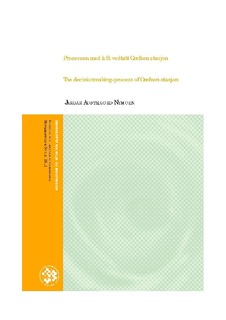Prosessen med å få vedtatt Grefsen stasjon
Master thesis
Permanent lenke
http://hdl.handle.net/11250/188162Utgivelsesdato
2011-09-21Metadata
Vis full innførselSamlinger
- Master's theses (ILP) [763]
Sammendrag
Sammendrag
Denne oppgaven fokuserer på beslutningsprosessen til utbyggingsprosjektet Grefsen stasjon i Oslo.
Det blir sett på hvorfor det tok så lang tid å få prosjektet vedtatt og hvorfor det tilslutt ble vedtatt.
Oppgaven ser på hvordan det private aktørers møte med det offentlige beslutningsmyndighetene
fungerer.
Som en følge av det offentliges rolle som boligbygger har blitt nedjustert er det i dag hovedsakelig
private aktører som står for planleggingen og utbyggingen av nye bygg. Det er ikke alltid de
overordnede planleggingsverktøyene fungerer etter hensikten og dette kan utgjøre en utfordring for
det offentliges beslutningsapparatets forutsigbarhet. En privat aktør må få sitt planforslag vedtatt av
det offentlige for å kunne få virkeliggjøre den, noe som betyr at de må engasjere seg i denne
prosessen.
Det har blitt estimert en kraftig befolkningsvekst i Oslo de neste 20 årene, og det er en overordnet
føring at denne veksten skal skje i byggesonen. Det er også ønskelig at denne kommende
utbyggingen skal foregå nærme kollektivtransport for å redusere bilbruk. Ved å bygge ut tett i
sentrale strøk kan dette i tilfeller også bety at det er flere som føler seg berørt av planene og kan
derfor være uenige dem. I det studerte case Grefsen stasjon var dette tilfelle.
Dette prosjektet brukte nærmere ti år på å bli vedtatt og en del av grunnen til dette kommer av en
gjennomført naboaksjon. Utgangspunktet for saksbehandlingen var forslagstillers svært ambisiøs
plan mens kommunen hadde forespeilet seg en mindre utnyttelse.
Underveis i prosessen har ulike parter drevet med lobbyvirksomhet og det var gjennom kontakt med
politikere motstandere av prosjektet fikk snudd et tilsynelatende flertall i bystyret til å stemme for å
utsette saken. Dette kom av at det var valgår og det kan virke som politikerne var bevist dette.
Prosjektet ble til slutt vedtatt i 2008 med et planforslag som ikke var så ulikt det tidligere utsatte
planforslaget. Summary
The theme of this thesis are the decisionmaking-process to the development project called Grefsen
stasjon in Oslo. The thesis focus on why the project such a long time to get approval from the
authority and why it finally got adopted.
As a result of a role reduction in the public sector's housingdevelopment, it is mainly the private
sector that are doing the planning and construction of new buildings today. The superior planning
tools does not always work as intended and that can pose a challenge for the public decision-making
authorities predictability. A private developer must have his plan proposal adopted by the public
authorities in order to be able to realize it, and will therefore engage in this decisionmaking-process.
It has been estimated a strong population growth in Oslo over the next 20 years and there is a
superior recognition that this growth will occur in the construction zone. It is also desirable that the
upcoming development take place close to public transport to reduce use of cars. By developing the
urban central areas, may this also in some cases mean that there are several concerned by the plan
and therefore disagree. In the studied project Grefsen stasjon, neighbours opposed the plans.
This project used nearly ten years to be adopted by the planing authorities and part of the reason
comes from a consistent neighbour action. In the beginning the developer made a very ambitious
plan while the municipality had predicted a smaller utilization.
During the process, lobbying was used by various parts and it was through contacts with politicians
opponents of the project had turned an apparent majority on the council to vote to delay the plans.
The reason for the change in voting may be in the fact that it was election year and it may seem that
the politicians were proven this.
The project was finally approved in 2008 with a plan that was not so different from the previously
deferred planning-proposal.
